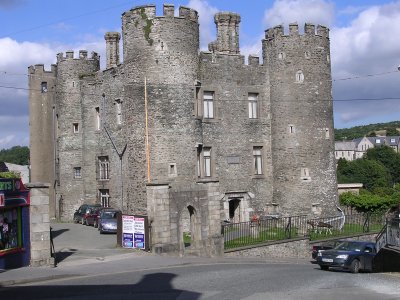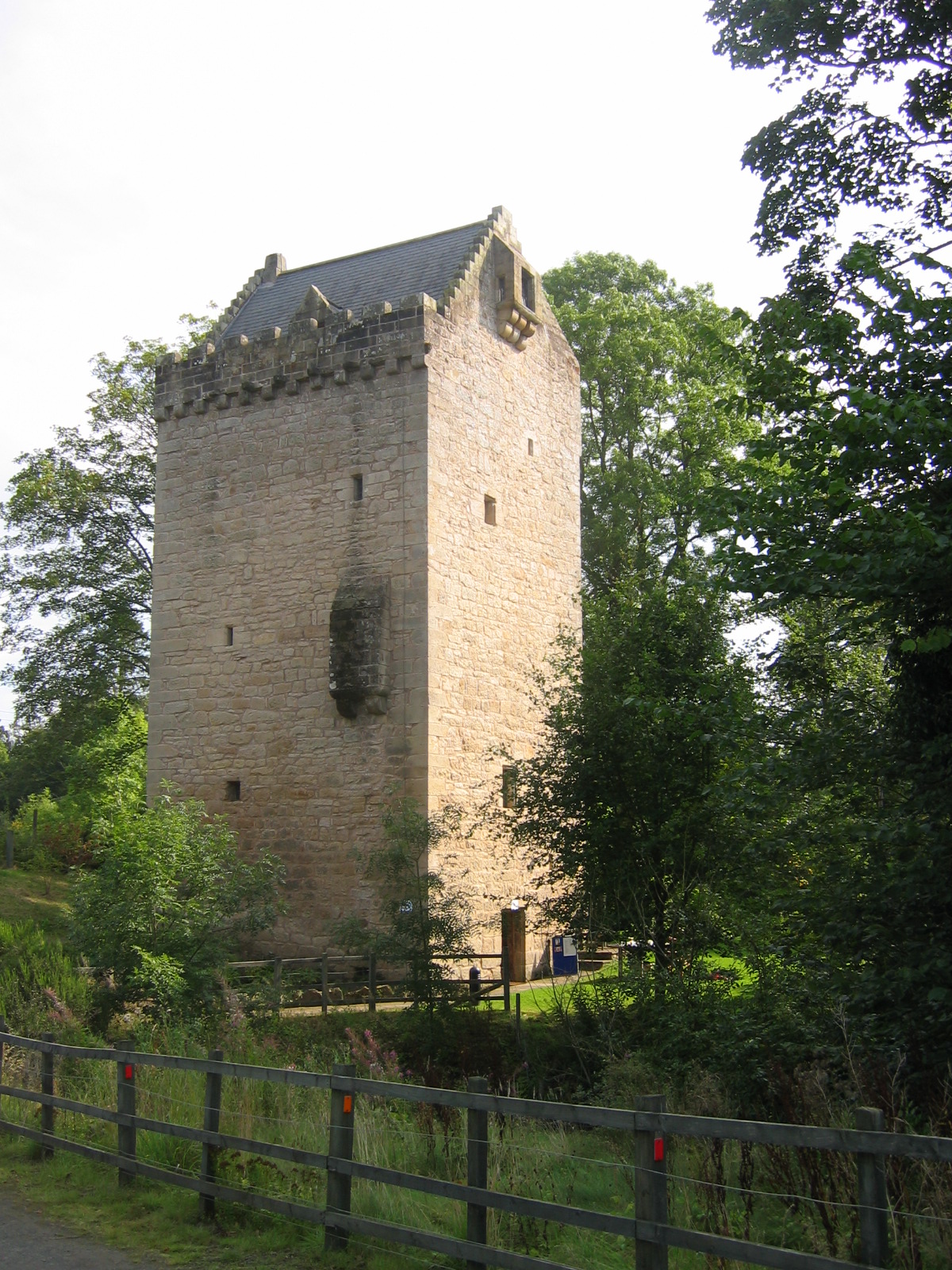|
Tellarought Castle
Tellarought Castle is a fortified tower house located approximately 10.8 km south-east of New Ross, County Wexford, Ireland. Location The ruin, with four walls still standing but partly overgrown, lies immediately adjacent to the road known as St Brigid's Terrace, off the R734 road, which runs from near New Ross to Tintern Abbey and Fethard. It is in a field just west of the graveyard of St. Brigid's Roman Catholic church, which serves Terrarath (an alternate form of the locale's name) within Cushinstown Parish. Building and history The building is a ruined tower house, a lightly fortified dwelling, dating to the Anglo-Norman period. It was held by the Sutton family in 1307, and may have been the property of one William Devoreux of Talleraght who is mentioned as being the recipient of a pardon in 1597 in the Elizabethan Fiants. By 1641 it appears to have been held by a Matthew Forde, though it may have been in disrepair by the Civil Survey of the mid-1650s. The towe ... [...More Info...] [...Related Items...] OR: [Wikipedia] [Google] [Baidu] |
New Ross
New Ross (, formerly ) is a town in southwest County Wexford, Ireland. It is located on the River Barrow, near the border with County Kilkenny, and is around northeast of Waterford. In 2016 it had a population of 8,040 people, making it the fourth-largest town in the county. History The port town of New Ross dates from the pre-Middle Ages. The earliest settlement in this area dates to the 6th century when St. Abban of Magheranoidhe founded a monastery in what is now Irishtown. The original earthen banked circular enclosure of his monastery was visible around the graveyard until it was removed by the council. It was replaced by a concrete wall and steel fence. Its name, ''Ros'', was shortened from ''Ros Mhic Treoin'', or ''the Wood of the Son of Treoin''. New Ross was in the territory of Dermot McMurrough and came to prominence when the Anglo-Normans conquered the region. The Norman knight William Marshall and his bride Isabella de Clare arrived during the early ... [...More Info...] [...Related Items...] OR: [Wikipedia] [Google] [Baidu] |
County Wexford
County Wexford ( ga, Contae Loch Garman) is a Counties of Ireland, county in Republic of Ireland, Ireland. It is in the Provinces of Ireland, province of Leinster and is part of the Southern Region, Ireland, Southern Region. Named after the town of Wexford, it was based on the historic Gaelic Ireland, Gaelic territory of Uí Ceinnselaig, Hy Kinsella (''Uí Ceinnsealaigh''), whose capital was Ferns, County Wexford, Ferns. Wexford County Council is the Local government in the Republic of Ireland, local authority for the county. The population of the county was 149,722 at the 2016 census. History The county is rich in evidence of early human habitation.Stout, Geraldine. "Essay 1: Wexford in Prehistory 5000 B.C. to 300 AD" in ''Wexford: History and Society'', pp 1 - 39. ''Portal tombs'' (sometimes called dolmens) exist at Ballybrittas (on Bree Hill) and at Newbawn — and date from the Neolithic period or earlier. Remains from the Bronze Age period are far more widespread. E ... [...More Info...] [...Related Items...] OR: [Wikipedia] [Google] [Baidu] |
R734 Road (Ireland)
The R734 road is a regional road in County Wexford, Ireland. It travels from the R733 road at Slaght to Hook Head Lighthouse via the village of Fethard-on-Sea Fethard-on-Sea or Fethard () is a village in southwest County Wexford in Ireland. It lies on the R734 road on the eastern side of the Hook peninsula, between Waterford Harbour and Bannow Bay. The village had a population of 311 as of the .... The R734 is long. References Regional roads in the Republic of Ireland Roads in County Wexford {{Ireland-road-stub ... [...More Info...] [...Related Items...] OR: [Wikipedia] [Google] [Baidu] |
Tower House
A tower house is a particular type of stone structure, built for defensive purposes as well as habitation. Tower houses began to appear in the Middle Ages, especially in mountainous or limited access areas, in order to command and defend strategic points with reduced forces. At the same time, they were also used as an aristocrat's residence, around which a castle town was often constructed. Europe After their initial appearance in Ireland, Scotland, the Frisian lands, Basque Country and England during the High Middle Ages, tower houses were also built in other parts of western Europe, especially in parts of France and Italy. In Italian medieval communes, urban ''palazzi'' with a very tall tower were increasingly built by the local highly competitive patrician families as power centres during times of internal strife. Most north Italian cities had a number of these by the end of the Middles Ages, but few now remain, notably two towers in Bologna, twenty towers in Pa ... [...More Info...] [...Related Items...] OR: [Wikipedia] [Google] [Baidu] |
Irish Language
Irish (an Caighdeán Oifigiúil, Standard Irish: ), also known as Gaelic, is a Goidelic languages, Goidelic language of the Insular Celtic branch of the Celtic language family, which is a part of the Indo-European languages, Indo-European language family. Irish is indigenous language, indigenous to the Ireland, island of Ireland and was the population's first language until the 19th century, when English (language), English gradually became Linguistic imperialism, dominant, particularly in the last decades of the century. Irish is still spoken as a first language in a small number of areas of certain counties such as County Cork, Cork, County Donegal, Donegal, County Galway, Galway, and County Kerry, Kerry, as well as smaller areas of counties County Mayo, Mayo, County Meath, Meath, and County Waterford, Waterford. It is also spoken by a larger group of habitual but non-traditional speakers, mostly in urban areas where the majority are second language, second-language speakers. ... [...More Info...] [...Related Items...] OR: [Wikipedia] [Google] [Baidu] |
Castles In County Wexford
A castle is a type of fortified structure built during the Middle Ages predominantly by the nobility or royalty and by military orders. Scholars debate the scope of the word ''castle'', but usually consider it to be the private fortified residence of a lord or noble. This is distinct from a palace, which is not fortified; from a fortress, which was not always a residence for royalty or nobility; from a ''pleasance'' which was a walled-in residence for nobility, but not adequately fortified; and from a fortified settlement, which was a public defence – though there are many similarities among these types of construction. Use of the term has varied over time and has also been applied to structures such as hill forts and 19th-20th century homes built to resemble castles. Over the approximately 900 years when genuine castles were built, they took on a great many forms with many different features, although some, such as curtain walls, arrowslits, and portcullises, w ... [...More Info...] [...Related Items...] OR: [Wikipedia] [Google] [Baidu] |

_p223_Map_of_New_Ross%2C_c.1680.jpg)



